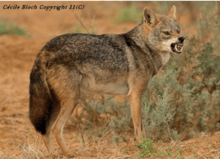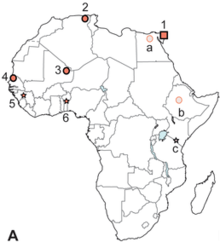Egyptian jackal
| Egyptian jackal African wolf | |
|---|---|
 | |
| Scientific classification | |
| Kingdom: | Animalia |
| Phylum: | Chordata |
| Class: | Mammalia |
| Order: | Carnivora |
| Family: | Canidae |
| Genus: | Canis |
| Species: | Canis aureus |
| Subspecies: | C. a. lupaster |
| Trinomial name | |
| Canis aureus lupaster (Hemprich and Ehrenberg, 1833) | |
 | |
| Synonyms | |
|
C. lupaster | |
The Egyptian jackal is a canid of unresolved taxonomic identity native to northern, eastern and western Africa. Throughout much of the 20th century, the animal was classed as a subspecies of golden jackal, Canis aureus lupaster. Notice was however taken by numerous zoologists of the animal's morphology, which corresponds more to that of the grey wolf. This was corroborated through mtDNA studies, which showed that the animal is a subspecies of grey wolf, and should be renamed African wolf (Canis lupus lupaster). Nevertheless, it has not been formally recognised as such by MSW3 which, as of 2005,[1] still classifies it as a subspecies of golden jackal.
Lupaster differs from the Senegalese jackal by its heavier build, wider head, thicker fur, longer legs, more rounded ears, and shorter tail. The fur is darker than the golden jackal's, and has a broader white patch on the chest. Field observations in Senegal's Djoudj National Bird Sanctuary indicate that it is a solitary animal that lives on the periphery of golden jackal territories, and dominates the latter species in disputes over carcasses. According to local shepherds, while the golden jackal preys primarily on lambs, lupaster attacks larger prey, such as sheep, goats and cattle. Lupaster inhabits a number of different habitats; in Algeria it lives in Mediterranean, coastal and hilly areas (including hedged farmlands, scrublands, pinewoods and oak forests), while populations in Senegal inhabit tropical, semi-arid climate zones including Sahelian savannahs. Lupaster populations in Mali have been documented in arid Sahelian massifs.[2]
Taxonomic history
_C._l._lupaster_%26_C._a._aureus.png)
Aristotle was the first European to write of wolves in Egypt, mentioning that they were smaller than the Greek kind. Georg Ebers wrote of the wolf being among the sacred animals of Egypt, describing it as a "smaller variety" of wolf to those of Europe, and noting how the name Lykopolis, the Ancient Egyptian city dedicated to Anubis, means "city of the wolf". Hemprich and Ehrenberg, upon seeing similarities between North African jackals and wolves in 1832, gave the animal the binomial name Canis lupaster. Likewise, Thomas Henry Huxley, upon noting the similarities between the skulls of lupaster and Indian wolves, classed the animal as a subspecies of grey wolf. However, the animal was classed as a golden jackal by Ernst Schwarz in 1926. This classification remained unquestioned until 1981, when zoologist Walter Ferguson of the Tel Aviv University argued in favour of lupaster being a subspecies of grey wolf based on cranial measurements, stating that the classing of the animal as a jackal was based solely on the animal's small size, and predated the discovery of C. l. arabs, which is intermediate in size between C. l. lupus and lupaster.[3]
The debate was rekindled in December 2002, when a canid was sighted in Eritrea's Danakil Desert, whose appearance didn't correspond to that of the golden jackal or the six other recognised species of the area, but strongly resembled that of the grey wolf. The area had previously been largely unexplored, due to its harsh climate and embroilment in the Eritrean War of Independence and subsequent Eritrean–Ethiopian War, though local Afar tribesmen knew of the animal, and referred to it as wucharia (wolf).[4] In 2011, 2,055 base pairs from the mtDNA of "Egyptian jackal" samples taken from the Ethiopian Highlands were analyzed and compared with those of grey wolves and other wolf-like canids. The results showed, with 100% bootstrap support, that the canid was indeed a grey wolf. The results also revealed that the animal's range was much more extensive than previously thought, as the Ethiopian samples taken from two localities were located approximately 2,500 km southeast of Egypt.[5] A further study confirmed the taxon's presence in Algeria, Mali and Senegal, thus expanding its range around 6,000 km west of the original study. Genetic analyses indicated that the African wolf is, alongside the Indian and Himalayan wolf, an ancient subspecies originating from before the radiation of Holarctic wolves (which gave rise to dogs, North American and most Eurasian grey wolf subspecies). However, unlike the Indian and Himalayan populations, the African wolf shows much more nucleotide and haplotype diversity, indicating a larger ancestral population, and an effective extant population of around 80,000 females.[2]
References
- ↑ Wozencraft, W. C. (2005). "Order Carnivora". In Wilson, D. E.; Reeder, D. M. Mammal Species of the World (3rd ed.). Johns Hopkins University Press. pp. 532–628. ISBN 978-0-8018-8221-0. OCLC 62265494.
- ↑ 2.0 2.1 Gaubert P, Bloch C, Benyacoub S, Abdelhamid A, Pagani P et al. (2012). "Reviving the African Wolf Canis lupus lupaster in North and West Africa: A Mitochondrial Lineage Ranging More than 6,000 km Wide". PLoS ONE 7 (8): e42740. doi:10.1371/journal.pone.0042740. PMC 3416759. PMID 22900047.
- ↑ Ferguson, W.W. (1981). "The systematic of Canis aureus lupaster (Carnivora : Canidae) and the occurrence of Canis lupus in North Africa, Egypt and Sinai". Mammalia 4: 459–465.
- ↑ Tiwari, J. K.; Sillero-Zubiri, C. (2004). "Unidentified Canid in Horn of Africa" (PDF). Canid News 7: 5.
- ↑ Rueness, E. K.; Asmyhr, M. G.; Sillero-Zubiri, C.; MacDonald, D. W.; Bekele, A.; Atickem, A.; Stenseth, N. C. (2011). Gilbert, Thomas M, ed. "The Cryptic African Wolf: Canis aureus lupaster is Not a Golden Jackal and is Not Endemic to Egypt". PLoS ONE 6 (1): e16385. doi:10.1371/journal.pone.0016385. PMC 3027653. PMID 21298107.
Further reading
| Wikimedia Commons has media related to Canis aureus (lupus) lupaster. |
- Osborn, D. J. & Helmy, I. (1980), The contemporary land mammals of Egypt (including Sinai), Fieldiana Zoology new series, no.5, pp. 361-71